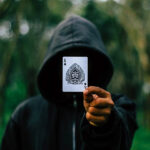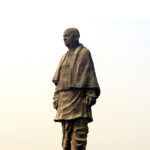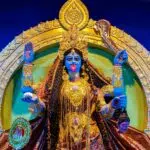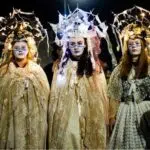Kali Puja takes place between October and November during the new moon of the Hindu month of Kartik. This year, it takes place on October 24. It’s a day dedicated to Kali — the goddess of life, death, and transcendence. As goddesses go, Kali is one of the most fascinating in Hindu mythology. The scriptures describe her as a dark woman with four arms — one hand yielding a sword and the other with the head of a slain demon. Kali wears a necklace of skulls. She stands menacingly with her tongue protruding from her mouth.In some areas, she retains the status of a tribal goddess — protecting people and specific regions. To others, she’s the mother of universal strength or represents divine fury. Regardless of multiple depictions, Kali’s many forms indicate her transformative power. Goddess Kali finds a special place in the hearts of the Bengalis, Assamese, and Odia in India. Kali Puja is their version of Diwali, traditionally the more Pan-Indian festival.
History of Kali Puja
While the rest of India celebrates Diwali and Laxmi Puja, the state of West Bengal does things differently. You’ll uncover different rituals, customs, and foods. And unlike the rest of the country, worship (puja) in West Bengal involves the fierce goddess, Kali. Kali symbolizes divine energy or shakti. She destroys evil within the world and outside it — the universe owes its redemption to her. Kali (also called Kalika) is the first among 10 indomitable goddesses or the Dasa Mahavidyas of Hindu mythology.Her name also means time, death, and darkness. If one looks at statues depicting her likeness, it’s easy to see why. Kali wears a garland containing the heads of decapitated demons with one foot on Lord Shiva’s chest. It’s an awe-inspiring, terrifying sight and a story with great mythological significance.Legends say that two demons (Nishambhu and Shambu) once roamed the heavens, creating chaos and destruction in the realm of Indra (the King of Gods.) The demons became powerful, forcing the Gods to take refuge in the Himalayas, where they sought guidance from Goddess Durga. To restore balance, Kali was born out of Durga’s forehead.Kali embarked on a quest to destroy the demons. She killed them and made a garland of their heads to wear around her neck. But power and rage overwhelmed Kali. She went on a rampage, slaughtering everyone in her path. Lord Shiva decided to intervene, but a rage-fuelled Kali stepped on Shiva unknowingly. She finally realized what she had done. When you look at popular depictions of the goddess Kali, artists and sculptors immortalize this moment in mythology.The legend has been around since the dawn of time. The festival, not so much. Kali Puja celebrations gained popularity in West Bengal as recently as the 19th century. King Krishnachandra of Navadvipa spearheaded the movement, along with wealthy landowners in Bengal. Although ordinary folk went along with it initially to avoid the king’s wrath, the practice slowly became a tradition. Today, Kali Puja and Durga Puja are synonymous with life and culture in Bengal. People pay tribute at various Kali temples and shrines. Some embark on long pilgrimages for her. Celebrations each year are grand and only get bigger.
Kali Puja timeline
The mercurial Kali exists as a tribal goddess outside institutionalized and elite religious systems.
Goddess Kali emerges as the incarnation of Goddess Durga’s fury in the "Markandeya Purana.
The esoteric traditions of Tantra worship Kali’s most dangerous form — Samhara Kali, epitomizing death and destruction.
Aristocrats and wealthy landowners in Bengal order their subjects to observe Kali Puja.
Kali Puja FAQs
Are Kali Puja and Diwali the same?
Both Kali Puja and Diwali fall on the same day. While most of India worships Goddess Laxmi on this day, people in Eastern India worship Goddess Kali instead.
What do you eat on Kali Puja?
The main prasad (devotional offering) during the puja is Bhoger Khichuri. It’s a traditional Bengali dish made with rice, lentils, vegetables, and spices.
Can I worship Kali at home?
People can pray to Kali both at home or inside a temple. Kali Puja at home usually involves chanting and meditation in a designated sacred space.
Kali Puja Activities
-
Attend Kali Puja
Families in West Bengal pay tribute to Goddess Kali in temples or at home. The puja takes place at night. People offer red hibiscus flowers (the goddess’ favorite), rice, sweets, and lentils, followed by feasting the next day.
-
Visit the Kalighat temple
Join thousands of pilgrims at the magnificent Kalighat temple in Kolkata city. The temple is one of the most important sites of Goddess Kali.
-
Feast until you can’t anymore
The food during Kali Puja represents Bengal's diverse population. From the iconic Bengali mutton curry and Hakka Chinese delicacies to Mughal-inspired cuisine — sample every dish.
5 Facts About Bengal That Will Blow Your Mind
-
The first capital of British India
The British ruled India from the city of Calcutta (now Kolkata) until 1931 when the headquarters shifted to New Delhi.
-
Home to Nobel Laureates
As India's proverbial intellectual center, Bengal has produced Nobel Laureates including the likes of Rabindranath Tagore, Sir CV Raman, Amartya Sen, Mother Teresa, and Sir Ronald Ross.
-
Mad about football
The Calcutta Football League was born in 1898 and is one of the oldest in India.
-
Cricket’s answer to the Colosseum
Kolkata’s sprawling Eden Gardens is the world’s third-largest cricket stadium.
-
India’s only Chinatown
Kolkata’s Tangra area is India’s only Chinese settlement, where Hakka Chinese immigrants have lived peacefully since their arrival in the late 18th century.
Why We Love Kali Puja
-
An uncommon goddess
Kali Puja is a homage to a goddess unlike any other. Kali is far from ethereal, beautiful, or maternal in the traditional sense. Kali demands the world pay attention to its sins and chances for redemption
-
One religion, diverse traditions
Today is perfect for experiencing Hindu traditions that go against the grain. Kali Puja in West Bengal provides incomparable insights into the complex layers of Hinduism.
-
The glorious food
West Bengal is known for many things, and gastronomical joy tops the list. Kali Puja offers a taste of the state’s legendary cuisine.
Kali Puja dates
| Year | Date | Day |
|---|---|---|
| 2022 | October 24 | Monday |
| 2023 | November 12 | Sunday |
| 2024 | October 31 | Thursday |
| 2025 | October 20 | Monday |
| 2026 | November 9 | Monday |































